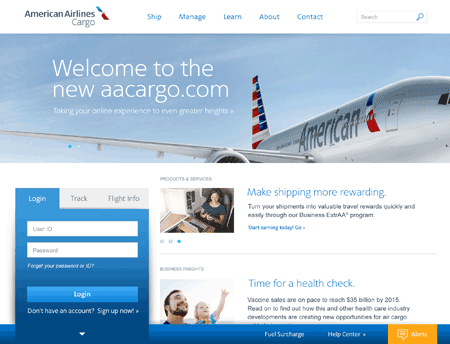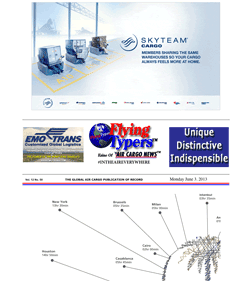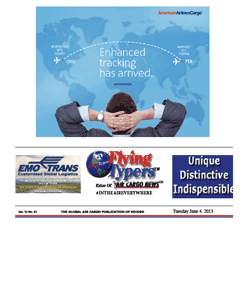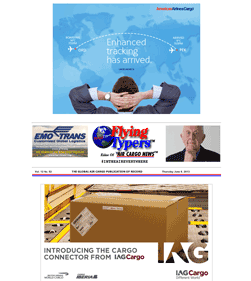 |
 |
|
| |
||
|
Vol. 12 No. 53 THE GLOBAL AIR CARGO PUBLICATION OF RECORD Monday June 10. 2013 |
|
|
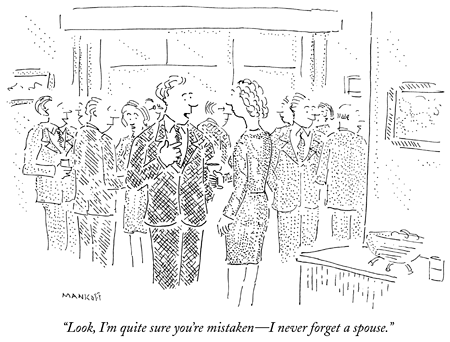 |
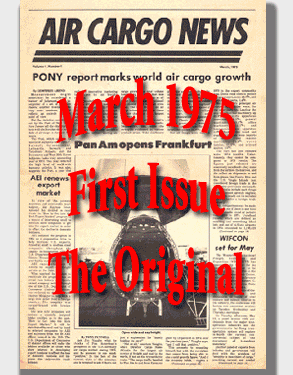 |
|
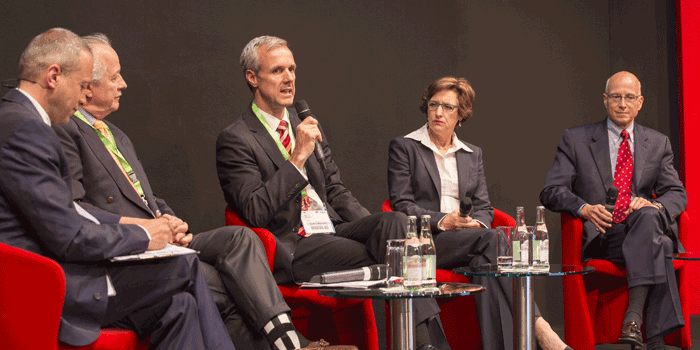 |

 Bernd
Maresch, Managing Director,
Hans Mars as moderator was joined
by panelists Lise-Marie Turpin,
Vice President Cargo, Air Canada
Cargo, Niko Herrmann, Partner
AAD - Aviation, Aerospace &
Defense, Oliver Wyman Prof.
Dr. J. Rod Franklin, P.E., Managing
Director, Executive Education
Adjunct Professor of Logistics,
The Kühne Logistics University,
Didier Lenormand, Head of Marketing
- Freighters, Airbus Central
Entity.
Bernd
Maresch, Managing Director,
Hans Mars as moderator was joined
by panelists Lise-Marie Turpin,
Vice President Cargo, Air Canada
Cargo, Niko Herrmann, Partner
AAD - Aviation, Aerospace &
Defense, Oliver Wyman Prof.
Dr. J. Rod Franklin, P.E., Managing
Director, Executive Education
Adjunct Professor of Logistics,
The Kühne Logistics University,
Didier Lenormand, Head of Marketing
- Freighters, Airbus Central
Entity.
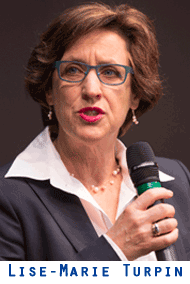 The
group wonders where and how
air cargo might change to build
load factors and break the grip
of human controlled processes.
The
group wonders where and how
air cargo might change to build
load factors and break the grip
of human controlled processes.
The
proposition is on the table:
Is
it time for a breakthrough,
structural innovation, or must
the air freight sector make
do with small, incremental ‘micro-innovations’?
Prof.
Dr. Franklin opened the proceedings
with a short recap of where
the industry stood today.
While
the efficiency of aircraft has
improved dramatically in recent
years, capacity remains unused,
the cost of fuel has not reduced
and there are many ageing and
inefficient aircraft still in
use.
Dr.
Franklin said the industry is
trapped in a ‘bunker mentality’.
He
suggested the following areas
could be ripe for innovation:
“Systems
suffer from a lack of integration;
outdated technology and designs
address yesterday’s issues
and are inappropriate,”
he said.
“Air
cargo processes have not fully
adopted modern lean approaches.
“They
lack customer focus in design.
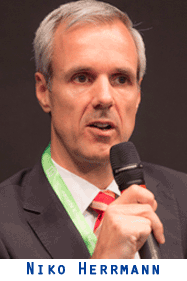 Dr.
Franklin added, “people
are not incentivized to innovate,
and not trained in creative
thinking, rather they are trained
to be operational.
Dr.
Franklin added, “people
are not incentivized to innovate,
and not trained in creative
thinking, rather they are trained
to be operational.
“Air
transport companies are under
pressure but have not upgraded
their transport technologies,
i.e. ageing and outdated equipment.
“Airport
infrastructure is optimized
for passenger handling and not
for cargo handling.”
The
panel raised some interesting
points in response:
More
focus needs to be put on the
value that air cargo brings
to the communities.
IATA’s
current education campaign is
a step in the right direction,
was one remark.
Taking
a broader sweep, another observation
was that air cargo should look
at what other industries are
doing.
Another
suggestion was that air cargo
should change the mind-sets
of our people to embrace technologies.
But
it was pointed out that change
is not necessarily accomplished
in giant leaps:
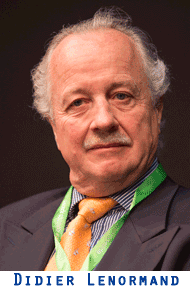 Small
innovations can really make
a difference. Two examples we
heard of, this day in Munich:
Small
innovations can really make
a difference. Two examples we
heard of, this day in Munich:
Example
one was the local replacement
of handheld terminals for barcode
reading.
Large
cumbersome expensive hand held
devices with a battery life
of six hours that required constant
changing and recharging were
replaced with a small application
on a smart phone.
Example
two: People would occasionally
miss their train because of
the queues at the automatic
ticket dispenser.
The
company developed a small application
that resided on a smart phone
that allowed people to buy tickets
using their credit card, which
removed the need to queue.
The
message and advice from this
panel is that the corporation
should not bind air cargo innovation.
To
be innovative, the industry
must look at innovative solutions
that can be done locally and
cheaply.
Air
cargo needs more balanced risk
taking.
Takeaway
from this session is that the
industry has shown it can move
quickly but only if it needs
to.
Such
had been the case with the implementation
of AMS in the U.S. and ICS in
Europe.
However
to this point in 2013, there
was agreement that much advancement
in air cargo has been reactive
and not proactive.
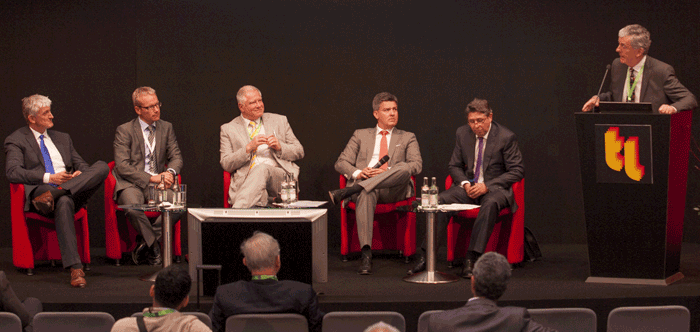 |

 The
moderator for the second and
last panel was Simon Keeble,
Publisher, The A-Z Group.
The
moderator for the second and
last panel was Simon Keeble,
Publisher, The A-Z Group.
He
was joined by panelists: Chris
Welsh, Secretary General, Global
Shippers´ Forum, Michael
Schächer, CEO, Transport
Transparency GmbH & ACG
Air Cargo Germany, Patrick Murray,
Head of Calogi, Mattijs ten
Brink, Senior Vice President
Sales & Distribution and
Member of the Management Board
of Air France KLM Martinair
Cargo, and Jan Markill, Sales
Director EMEA, Descartes Systems
Group Inc.
Initiatives
such as e-freight and Cargo
2000 continue to make slow progress,
while information and communication
technologies and channels have
been evolving rapidly throughout
business and society.
The
focus of this discussion was
set up around the proposition
that the air cargo sector needs
to ensure it is preparing for
the next generation of messaging
requirements, not the last generation.
Further
with the expectations of e-consumers
and retailers, for example,
in terms of information exchange
and the transparency of transport
services, what information will
consignees require the air freight
sector to exchange in 12 months’,
five years’ or 10 years’
time?
And
how well prepared is air cargo
to deliver?

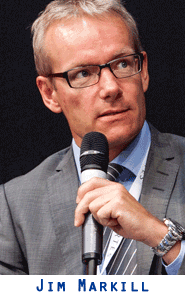 This
panel felt that we could certainly
learn from our passenger and
travel colleagues.
This
panel felt that we could certainly
learn from our passenger and
travel colleagues.
For
instance, the pax model for
electronic ticketing guarantees
100 % penetration and very few
data quality issues as the ticketing
data is validated by the airline
before the ticket is issued,
unlike the current e-AWB process.
The
panel also felt that the air
cargo industry lacks transparency
when compared to other industries,
Shippers, in particular want
to see more done by the airlines
and forwarders and a far more
proactive approach.
The
question was raised: whether
air cargo is preparing for the
last generation of messaging
requirements, or the next?
The
panel felt that the content
and quality of the message is
actually more important that
the format although it would
be good to see convergence on
one standard, i.e. XML, for
all modes of transport including
air.
Since
single window providers have
also embraced XML, members of
the panel felt this to be the
right move with some technology
providers already supporting
XML standards.
Migration
however may take some time and
maintaining two standards may
be required after IATA withdraws
support for Cargo-IMP. Finally
the panel felt that e-business
should really be the norm and
rather than look for returns
on investment, the message is:
get with the e-program or risk
being obsolete.

The
panel felt it should not be
left to IATA and Cargo 2000
to drive messaging.
IATA
and C2K are there to provide
standards and technology providers
are responsible for adopting
those standards.
However,
business leaders must drive
the implementation.
One
school of thought suggested
that C2K could perhaps promote
the C2K Master Operating Plan
to a wider audience.

Shippers
still want to see far more transparency
in terms of the information
that is shared with them and
service providers should be
investing in these areas, the
panel suggested.
For
instance if a shipment is delayed
or offloaded, the shipper should
be notified and the recovery
plan shared. Furthermore it
is hoped that shippers will
not need to exchange information
in years to come and that electronic
documents will be stored on
servers that can be accessed
via links. Some technology companies
have implemented similar systems
already.

This
panel hit on a study commissioned
by IATA that predicts that by
2017, 50% of passenger bookings
will be made using smart phones.
It
will be interesting to see how
many air cargo bookings will
be made in 2017, using this
medium.
With
a growing number of smart phone
users in the world, the smart
phone will become the medium
for doing business.
Some
airlines have recognized this
and have already implemented
track and trace for smart phones.
The
consensus is that the air cargo
industry cannot ignore this
trend.
Again,
back to Patrick Murray, who
for the purpose of total clarity
reminds us that he was part
of Panel Two.
“Two
interesting panels.
“I
love the idea that we should
embrace creative thinking and
train our people to do so.
“Also
I feel that we can learn from
other industries such as retail,
automotive and banking.
“Look
at how easy it is to do business
with them.
“I
also believe that when we build
new solutions and processes,
many of the objectives should
be focused on delivering what
the customer actually wants.
“It
is true to say that large corporations
do tend to retain central control
on spend, especially when it
comes to solutions.
“However,
allowing your local managers
to prepare local business cases
for the implementation of local
solutions is a good idea and
we have proven with Calogi,
that can be successful.
“We
do need to start taking some
measured risks,” Patrick
said.

Looking
back to the WCS in Doha that
tipped off the air cargo show
event season in what now seems
an eternity ago (it was
March 2013) and the presentation
by Cargo Airport Services in
which they described how they
had removed paper from their
import process by deploying
tablets in the warehouse, no
doubt this probably presented
a certain level of risk, which
they were prepared to take.
From
the presentation, it looks like
it has paid off.
Great
for them.
As
an industry air cargo needs
to take a long hard look at
how we share data.
Currently
we have millions of messages
being exchanged every year,
and the data is replicated several
times in a variety of servers.
“In
the ‘Brave New World’
I truly believe that data needs
to be housed and protected in
very few servers, with access
being granted to authorized
companies,” Patrick Murray
said.
“For
instance, the CITES organization
could have a central database
for all electronically signed
CITES certificates and instead
of issuing a certificate; they
would issue an encrypted link
to their server, which will
allow access to the specific
document.
“This
is not new as some do this already.
“However,
it will take investment and
a will to change how we do business,”
he concluded.

Overall
some very good messages, both
on IT and otherwise, from a
pair of air cargo panels last
Wednesday morning in Munich.
Much
on the table to share and learn
from the takeaway, but now it
is really down to the industry
to prove that we do not have
a ‘bunker mentality’,
(although after Prof. Dr. Franklin
utilized that phrase we kept
wondering: “which bunker
was he was referring to?”)
and that we can be as innovative
as our colleagues from other
industries.
Geoffrey
Get
On Board Air Cargo News
FlyingTypers |
If
You Missed Any Of The Previous
3 Issues Of FlyingTypers |
|||||
|
|||||
FT060313 |
FT060613 |
||||
|---|---|---|---|---|---|

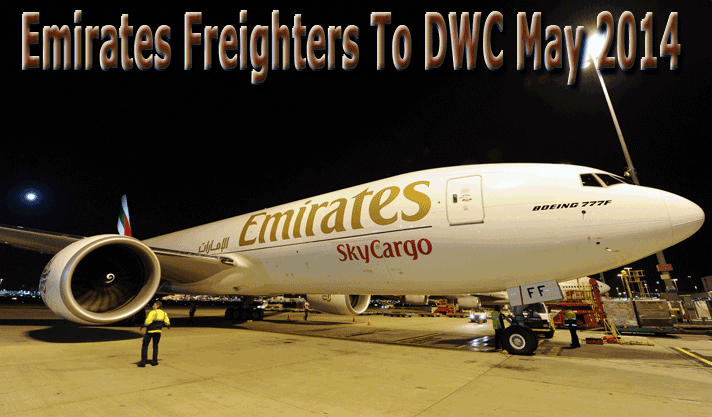
 ubai
World Central (DWC), that
dubs itself as “the
world’s first purpose-built
aerotropolis,” kicks
things up a notch as a source
told FT that Emirates
SkyCargo will move its freighter
operations from Dubai International
Airport (DXB) to DWC on May
1, 2014.
ubai
World Central (DWC), that
dubs itself as “the
world’s first purpose-built
aerotropolis,” kicks
things up a notch as a source
told FT that Emirates
SkyCargo will move its freighter
operations from Dubai International
Airport (DXB) to DWC on May
1, 2014. Backing
up a couple of years, it was
an Emirates B777 freighter
that officially was the first
flight to open the grand new
airport when the freighter
landed there on June 20, 2010.
Backing
up a couple of years, it was
an Emirates B777 freighter
that officially was the first
flight to open the grand new
airport when the freighter
landed there on June 20, 2010.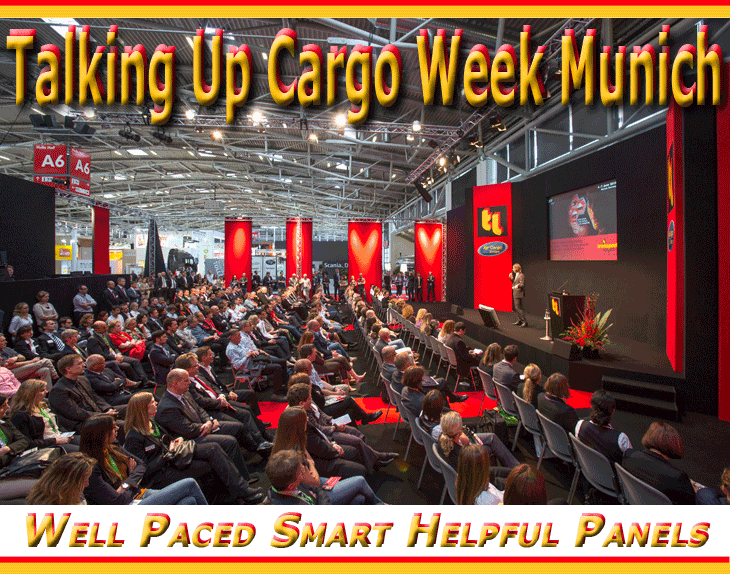
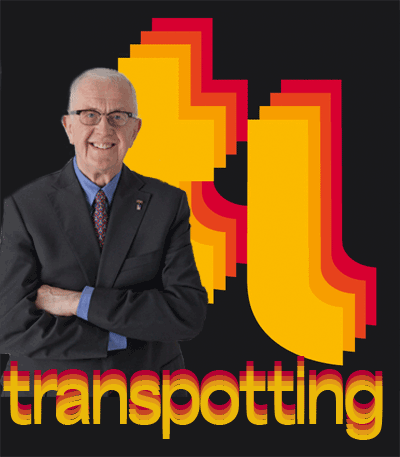
 he
one-day, one morning almost
painless meeting sessions at
Transport Logistics Air Cargo
Europe last week, were as it
is said, short and sweet, but
also heavy with content, especially
ideas toward innovation.
he
one-day, one morning almost
painless meeting sessions at
Transport Logistics Air Cargo
Europe last week, were as it
is said, short and sweet, but
also heavy with content, especially
ideas toward innovation.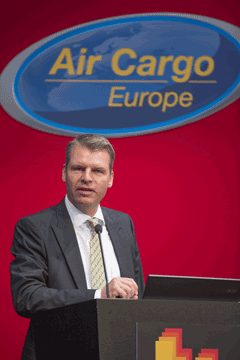 Dr.
Andreas Otto, Member of the
Executive Board Product and
Sales, Lufthansa Cargo AG delivered
a short but powerful message
to the industry, as always interesting
in his “Meet The Trends”
style of overview.
Dr.
Andreas Otto, Member of the
Executive Board Product and
Sales, Lufthansa Cargo AG delivered
a short but powerful message
to the industry, as always interesting
in his “Meet The Trends”
style of overview.  We
hear the e-freight mantra and
ask Patrick Murray, head of
fast-rising IT resource Calogi,
based in Dubai, for his take.
We
hear the e-freight mantra and
ask Patrick Murray, head of
fast-rising IT resource Calogi,
based in Dubai, for his take.